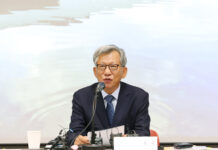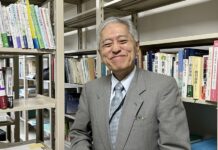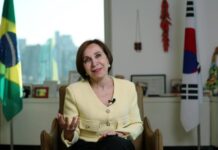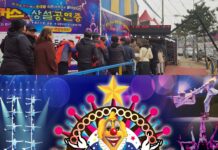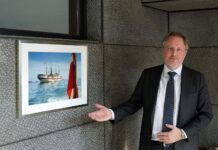When thinking about Korea, many people come up with images such as royal palaces, Hanbok and other traditional outfits, kimchi or pop music. A newly published book, however, covers wider aspects of Korea from a broader perspective.
This book is “Sketches of Korea,” published by Seoul Selection and written by Hongik University Professor Benjamin Joinau, who is from France and has been living in Korea for 20 years. His text is illustrated by Elodie Dornand de Rouville.
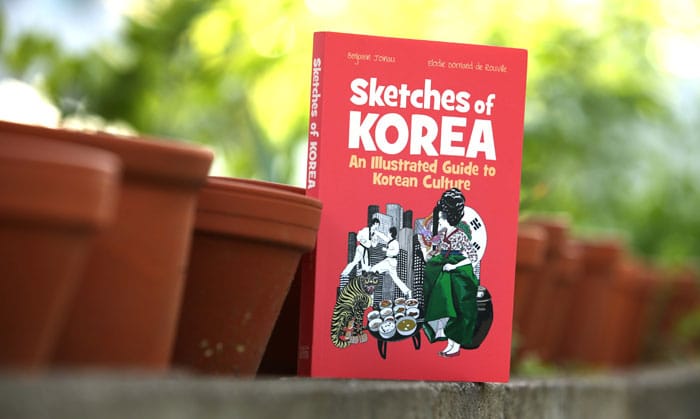
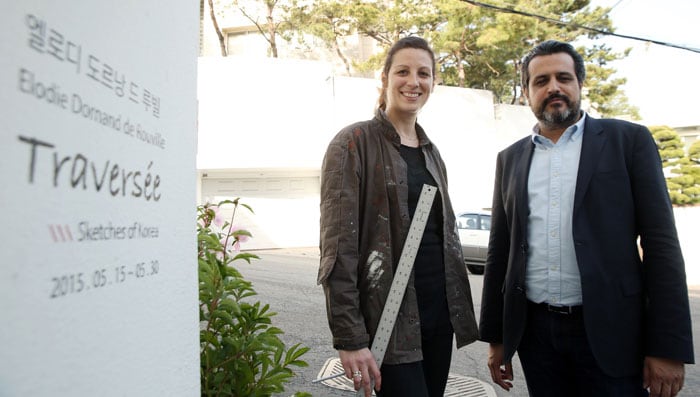
Hongik University Professor Benjamin Joinau (right) and Elodie Dornand de Rouville published the Korea guidebook ‘Sketches of Korea.’
The book focuses on specific aspects of Korea, such as drinking and how to make a poktanju, or a, “bomb drink,” the Korean word for a boilermaker: a cocktail made of one shot of liquor dropped into a glass of beer. The book covers cash gifts that are given on special occasions such as weddings, and even the fact that strangers at the public baths sometimes scrub each other’s backs. The book introduces Korean words such as kkotminam (꽃미남), a, “flower handsome man,” and hunnam (훈남), a, “kind, handsome man,” while explaining the social trend of valuing one’s facial appearance.
Professor Joinau doesn’t only explain today’s Korea. He writes about the traditional and artistic sides of Korean society and, of course, about Korean food as well, all with beautiful illustrations. When introducing the history of kimchi and how to prepare the dish, Joinau says, “Kimchi is the equivalent of the baguette in France or pasta in Italy. Kimchi is the true emblem of Korean national heritage,” while even referring to the dish as a “panacea.” In regard to traditional arts, he writes about not only various kinds of paintings, such as sansuhwa landscape paintings (산수화, 山水畵) and pungsokhwa genre paintings (풍속화, 風俗畵), but also about traditional furniture, aspects of which most modern citizens themselves are not aware.
Korea.net met with Professor Joinau to share his thoughts about modern and traditional society, culture, Korea and France.
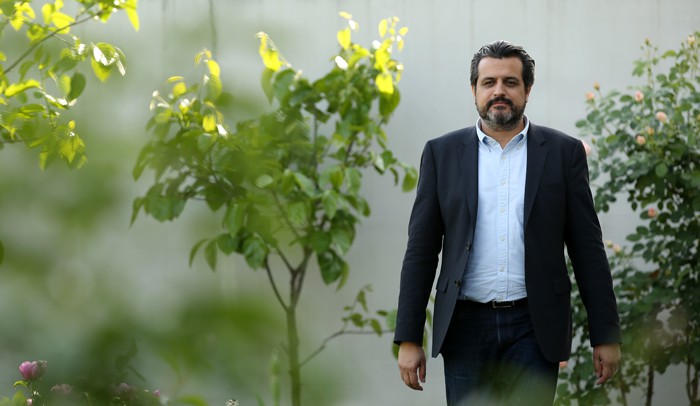
Professor Joinau says he wrote ‘Sketches of Korea’ to introduce some of the more realistic sides of life and society.
– What motivated you to write this book?
I’ve been in Korea for about 20 years. In the past, there were almost no books written in foreign languages about Korea, especially in French. So I had a lot of difficulties to prepare for my trip here when I first planned to come to Korea. In Korea, it was really difficult to find directions on the road. I particularly experienced many difficulties in terms of culture, too. It was interesting to solve a riddle. I thought there wasn’t enough information for the many people who didn’t have enough time, except for those who have an affinity for Korea like me.
At first, I wrote a travel book about Korea with a French publisher in 1998. This was my first book about Korea. It is a useful book, too, but I thought we needed a book that tells more about the “cultural knowledge” that it’s necessary for people to understand in order to find their direction on the road in Korea. Before I began to write this book, about six or seven years ago, there were books about Korea written in English. However, I thought we still needed more. Those books may be good-looking, but those were Korean books written from the Koreans’ point of view. Most of the content did not match with the perspective of non-Koreans. Though the target readers were non-Koreans, those books introduced only what Koreans considered most important. For example, a maedeup (매듭) is a decorative knot, or a podaegi (포대기) is a traditional carrier blanket for babies. They may both be considered “Korean things.” However, I didn’t think it had any depth, in terms of history or culture. These books were good to read, but just remained coffee table books. So Elodie and I thought we’d better include illustrated images to boost the effectiveness of the book, because people would see the images first rather than read the text. People always see visual images first. So we decided to write a picture book about Korea.
Then we decided to explain today’s Korea, the Korea we see every day, not in the past like during late Joseon times. The book should include traditional culture, of course, but we thought it would be stubborn to stick to only traditions because Koreans these days do not wear traditional hats, or gat, anymore, or Hanbok, or live in Hanok, traditional Korean homes. We thought we wouldn’t be able to introduce Korea properly if we only stuck to such aspects. So we decided to include the modern side of Korea, Korean society today.
– Its title is “Sketches of Korea.” However, in reality, its content is not as simple or light as mere sketches. It is a rather deep and much more informative book. Is there any reason you chose such a title?
In the first place, I planned to write the book in a light manner, just like a visual guidebook. When preparing the book, however, we realized that pictures and short explanations were not enough. So it turned out to be a “visual plus text” book. However, I don’t think this is an academic publication. As a sketch means a rough drawing without a lot of detail, I thought the word “sketch” would match as the title. It does not introduce Korea in a deep manner. However, it does contain many aspects of Korea that represent the country. This is a guidebook, not an academic book.
These days, many non-Koreans are coming to Korea. Many of them visit here with a certain interest in some part of Korean society, such as pop music or film. Our message is the fact that Korea is a complete country. This society is not about solely pop music, or films, or Samsung, or about Psy or “Gangnam Style.” This is an interesting country with a long history and great cultural diversity. About 50 years ago, the only thing people could know about Korea was the war or the Seoul Olympics in 1988. However, I believe that this should no longer be the case anymore.
Today, non-Koreans make many documentary films about Korea. Most of them still concentrate on specific sides of society, like the haenyeo, or female divers, of Jeju Island, court cuisine, the tea ceremony in Insa-dong or the strong passion for education as seen through students who study late into the night at hagwons, or private cram schools. This might have been understandable 20 years ago, but not today. I believe that nowadays we need to go further. Imagine you meet someone for the first time. You may exchange personal, basic information, such as your name and age. To get to know them better, however, and to become friends, you need to know the person in a deeper manner. This book does not go further into such detail, but I hope readers will be able to see Korea from a broader viewpoint. Korea is not solely about bibimbap, the war, the 1988 Olympics, pop music, movies, Samsung or Psy. I hoped they can see this country by taking an interest in the nation, the people and the politics.
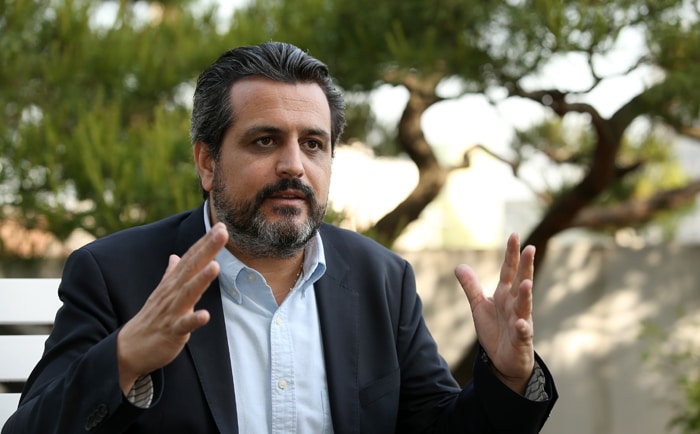
Professor Joinau emphasizes the need to introduce a wider perspective on Korean society, not solely focusing on limited aspects of the country.
– You outlined some specific scenarios common in Korean society, such as drinking, giving cash gifts on special occasions like weddings, or scrubbing each other’s backs at public bath houses. What criteria did you use to select items to include in the book?
I initially planned to write contributions for a monthly publication. At first, Elodie and I selected about 40 items and later made changes with the publisher. We made comprises during the process. Words like kkotminam or hunnam are good examples. These words were widely used when we first started the book, but those words are less used now, or some of them have even been forgotten as time has gone by. It is also hard to find the right definition because these are derived from pop culture and do not exist in a dictionary. Everyone has a different understanding and definition of these words, too. These may be regarded as trivial things, but I had difficulty with them.
Books like this take longer to write than academic books because I needed to double-check every fact and every detail. This is often the case when I check what we take for granted and it turns out to be false or to be a misunderstanding. I am not a walking dictionary or a specialist in every field of Korean culture, nor do I know Korean that well. So it took a long time.
– The book contains in-depth content, especially about traditional or artistic aspects of society, much of which native Koreans themselves are not aware. How and where did you collect your information and data? Did you face any difficulties?
In fact, it was not particularly difficult. I later majored in Korean studies and got a Ph.D. in it. I know how to find references and related data. Even though I know how to find such data, however, difficulties remained. For instance, let me take the section about Joseon-era clothing. Many people believe that Joseon people used to wear white, as Koreans were referred to as baegui minjok, or, “the white-clad folk” (백의민족, 白衣朝鮮). When I checked that, however, there were many theories that don’t match each other. There were times in early Joseon times when commoners were not allowed to wear white. The law permitted only yangban, the upper class, the elderly or children to wear white. The law existed since the reign of King Sejong the Great (r. 1418-1450). Then, the question arises: “What color did people wear during Joseon times?” In the travel accounts of non-Koreans who visited the country in the past, Koreans were described as being unique people who all put on white clothes. In reality, however, there are many academic essays that don’t line up with each other. As I am not an expert in this area, it wasn’t easy to deal with this in the book. Such limitations existed because I had to check every time.
Korean history also includes Goryeo (918-1392) and Silla (57 B.C.-A.D. 935), too, as well as Joseon (1392-1910), which was not easy to deal with in the book. When writing this book, I realized that I needed to study more. Still, however, I believe we needed to write such a book all the more.
– You’ve been in Korea for more than 20 years now. What has led you to stay in this country?
Originally, I was offered to come to Korea. I was supposed to stay here for two years, but when I finished my mission, I wanted to live here longer. That then continued, which extended my stay in the country. At that time, I didn’t think about living in Korea. When I lived here for about 10 years, I began to run a restaurant and I felt rooted to Korea. In fact, when I worked as a professor, many people seemed to think that I could go back home after living here for about two or three years. When I opened a restaurant, however, established a company and became a CEO, they thought differently about me. I felt like I got their recognition, which made me feel even more stable. From that point, I didn’t think about going back to France. Though I don’t run the restaurant anymore, I believe those roots made me settle in this country.
I ran a restaurant due to both financial and material issues. It was about 15 years ago when, as a non-Korean professor, I had to renew my contract every year. This involved systematic issues, as well. I hoped to teach in my field of interest and felt the need to become financially independent. I thought in a future-looking manner that if I were to run a restaurant, I would receive a visa that would help me do what I love to do: write books and continue with my research.
– What has been the favorite part of your life in Korea? On the other hand, what difficulties have you experienced living here?
Both questions have the same answer: living in a different country as a foreigner. This is very enjoyable and interesting, which makes me feel passionately about life every day. The life of a Westerner in Korea, however, reminds me of the fact that “I am not a Korean” every single day. Two or three years from now, I will have spent more time in Korea than in France. It seems that part of my identity has been Koreanized. Though I am a Frenchman, I think I have become a multicultural person. I find this very interesting, as if I have a complex identity. This is also painful and hard. Sometimes I feel like there is no way to become a Korean. This involves legal issues, as well. I can handle this, but the more important thing is about cultural issues. I think the Korean people need more cultural preparation to embrace people like myself as “Korean.” This will be different in the next generation. In fact, this will apply to Koreans who live overseas, too. This could be different, depending on in which country they live, though.
This makes me feel as if I live somewhere in a territory of ambiguity, neither as a stranger nor as a domestic person. Living in such territory is not always easy, but it is interesting. I accept this as my destiny — palja (팔자) in Korean — in an active manner. Exactly ten years ago, I thought that one day I would live in this space comfortably and happily. At that very moment, I decided not to go back to France.
– While living in Korea, are there any aspects of society or life here that you’ve found to be unique or that you haven’t been able to understand?
At first, I thought many things were strange, but not anymore. I came to understand them as I’ve lived here. Though not understandable, however, there is one thing I see as regretful. I hope Koreans can have more yeoyu, or free time, leisure or space in their lives. This does not always mean a vacation. It is more of an abstract concept. In other words, this means that people need a minimum psychological distance necessary between the subject, the object and the work they do. These days, many people emphasize creativity. To come up with creative ideas for economic development, however, I believe they need some mental distance in which to relax. Whether it be a student or an office worker, for example, how could they think up something creative while running through the same daily routine, from home to school or office, every day? I think it is pitiful that people are spending way too much time on their work or for the group. I doubt how productive this can be.
– Based on your book, you seem to have quite an affection for Korean traditions and the arts. Are there any aspects of Korean culture, traditions or the arts that you find particularly fascinating?
I love minhwa (민화, 民畫), or folk paintings. This is just my personal taste. Minhwa is a term invented during the Japanese colonial times. It covers different types of paintings which belonged to several genres in the past. I like the diversity of minhwa. I love paintings of ordinary people, and even own some paintings that were made into talismans. There seem to be many secretive symbols in the paintings, too, so it is interesting to look at them and they are very attractive. The more I study them at home, the more enjoyable it gets. These are simple and routine paintings, but they seem to have some unconsciously universal characteristics. Though I am not Korean, I feel something whenever I look at them. Many paintings are hung on my walls at home. Most of them are interesting works of art made between the late 19th and early 20th century.
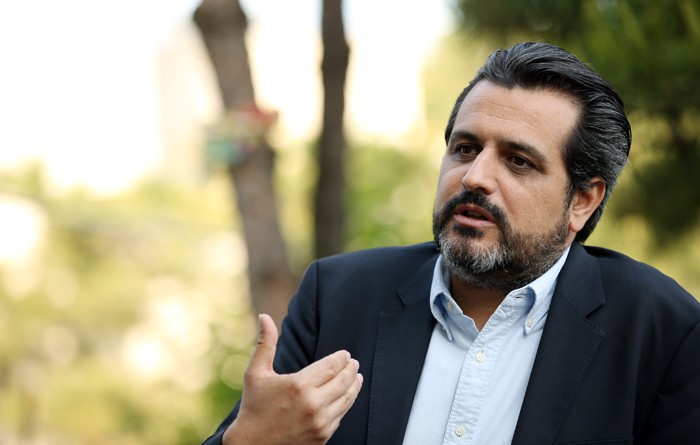
Professor Joinau says that settling in Korea is his fate and that he has accepted it in an active manner.
– What slices of Korean society or tradition would you want to introduce to your acquaintances overseas?
I live in Seochon in Hyoja-dong, underneath Inwangsan Mountain, in Seoul. I think my neighborhood has everything about Korea. Whenever my friends come to Korea, I bring them to my neighborhood. It has everything: downtown, nature, a mountain, the city, the countryside, the past, the present, an interesting food street, good restaurants and bars, Hanok homes and even a traditional market. There’s no need to go any farther. We can feel a very “Korean” living energy. All non-Koreans love it. I also recommend they go to the countryside, like to Jeolla-do (Jeolla Province), and stay at a Hanok bed and breakfast or at an old Hanok home, maybe at jongga, the head home of a respected clan.
– You have quite a unique background. You majored in philosophy, and later switched to cultural anthropology. You have run a French restaurant, worked as a food columnist and have even run your own cooking show on TV. Your interest in French and Korean cuisine is also impressive. What led you to focus on food and cooking?
A few years ago, I ran a TV show that introduced Korean food to non-Koreans. It was a very memorable experience. I visited the rural countryside and introduced all manners of Korean food. It was very interesting and I enjoyed it a lot.
It is kind of sad that academic circles still look down on food. This is maybe because they regard food as being only a small part of one’s daily routine, and that it is not worth any academic research. This is not true, of course. Food is something we eat every day. Eating is a necessity. But it is not a reason to see it as a non interesting subject for academics. If you look at history, for example, many revolutions were caused by food issues.
Studying food and the history of food is the basis of anthropological research, as we can see from Claude Levi Strauss (1908-2009). I believe it is not fair that food is not properly valued. Since the 1960s, there has been an academic rediscovery of everyday life, like in Michel De Certeau works of “The Practice of Everyday Life” in France. Such studies are very interesting. Though it may be a humble theme, once you study it, you can do a lot of in-depth studies in this area. I think we can all learn about Korea through its food. If we understand its food, we can know all about Korean culture because all people like food and take an interest in it. For this reason, I think we can attract non-Koreans’ attention with Korean food. We will then go further, deeper, like a trap.
– You seem to be passionate about promoting Korean cuisine, both through writing and in other media. Is there any one Korean food item that you find particularly unforgettable or memorable?
I have too many, so it is hard to pick just one. It depends on the situation. What I love to eat with friends on a rainy spring day will be different from what I wish to eat during the cold winter, or when I am alone. This is because I love Korean food as a whole. I enjoy the whole system and the taste of it. I love Korean food and understand it through my body. It doesn’t have to be luxurious court cuisine or served on fancy plates. I like baekban, or common Korean home-style meals, as long as the delicious side dishes are served with soup and rice. I was once sickened by sesame oil, but it was just a matter of time for me to get used to it. I love it more and more these days. Actually, this is also related to the matter of time and to relaxing. This can apply to the globalization of Korean food, as it needs more time to get used to it. To understand food with one’s body takes time.
– Despite a geographic distance, Korea and France have many opportunities to interact with each other. In Korea, people are interested in French art, literature, philosophy, food, fashion and so on. As a cultural anthropologist, what would you suggest people do in order to promote cultural exchange between the two countries in a desirable manner?
I do not know how to do it, but I truly want more active cultural exchanges. Korea and France have a lot in common, such as food, for example. Neither France nor Korea is a country that people can very easily find attractive. Despite the images of Paris or Korean pop music, one still needs time to fall in love. Once you fall in love with the country, however, the love will deepen and become long-lasting. For France, too, is not an easy country to understand. It needs time to feel its charms. It takes time to understand the complexities of these countries. If you feel the attraction, however, such emotions will last for a long time.
– Finally, what do you want to do in the future?
I hope to concentrate on writing books and conducting research. I will also continue to work on Korea-France cultural exchanges.
By Yoon Sojung
Photo: Jeon Han
Korea.net Staff Writers
arete@korea.kr


